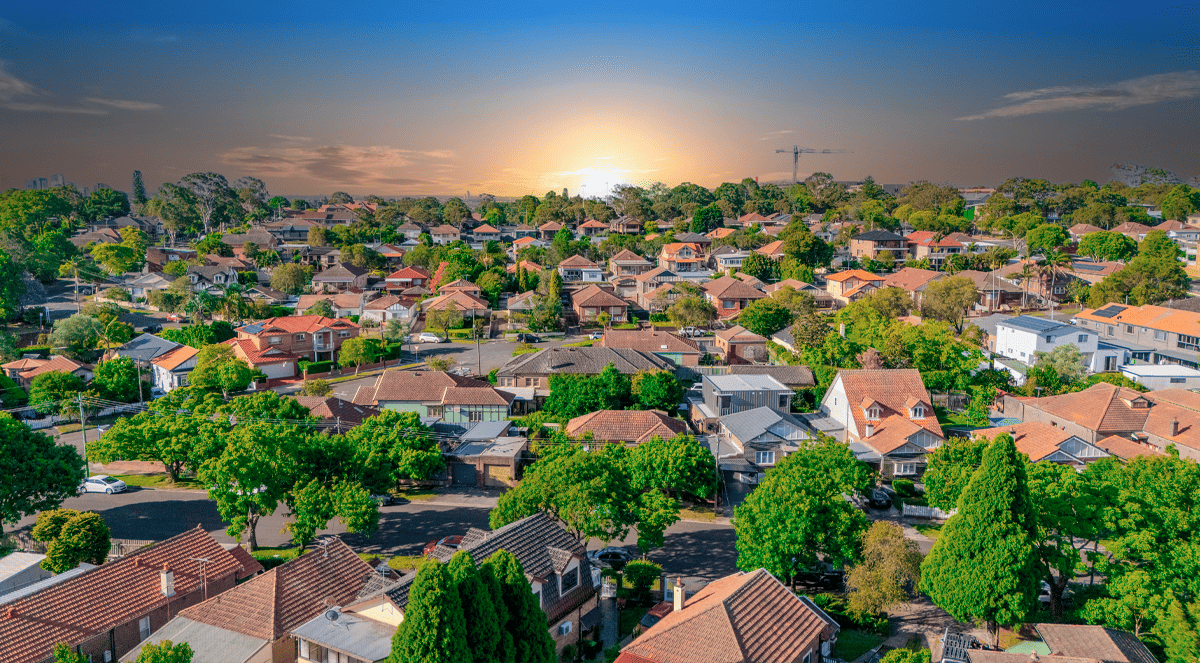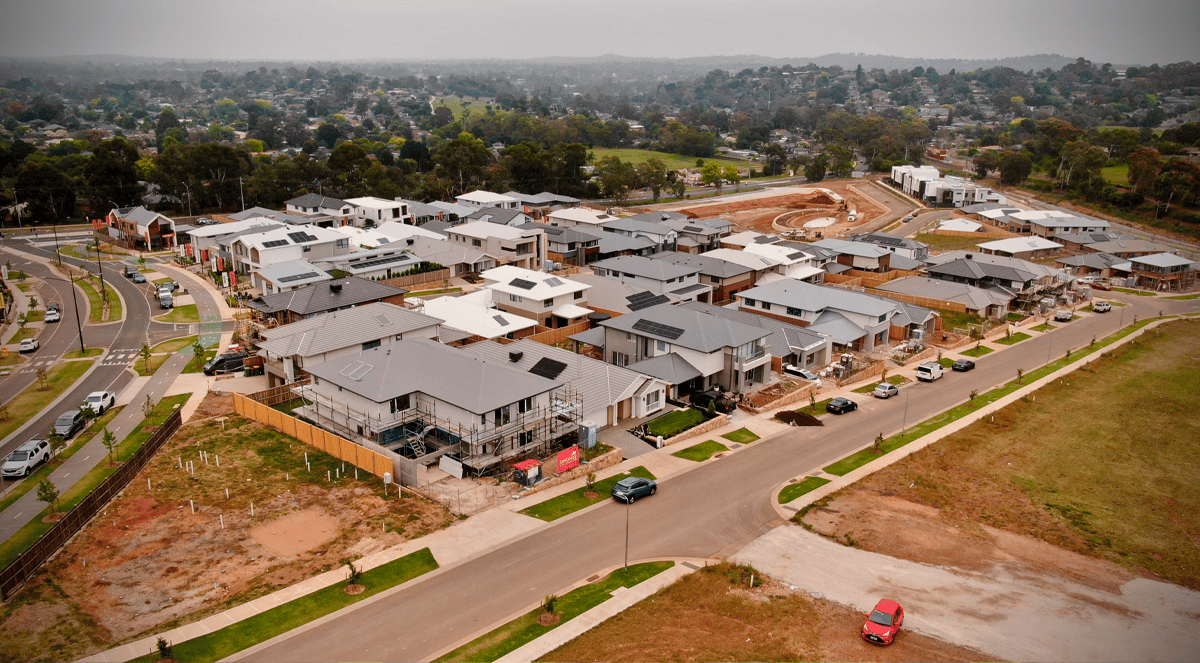Features > Property News & Insights > Market updates
The missing link between migration and housing policy
.png)
Image from AFP
KEY POINTS
- Since international borders reopened in 2022, Australia’s population has surged, largely due to overseas migration
- Housing construction has not kept pace with this big increase in population, which has contributed to soaring rental and property prices
- Housing analyst Cameron Kusher says Australia needs a population policy that links migration to housing, jobs, and infrastructure to ensure sustainable growth
New analysis of the link between overseas migration and the current housing crisis raises challenging questions for policymakers and governments.
“You shouldn't separate housing policy from migration policy” is a new paper penned by independent housing economist Cameron Kusher.
It’s an important piece of work that supports calls for a cohesive national population policy, directly linked to the delivery of housing, infrastructure and employment in Australia.
The details
Cameron Kusher is one of Australia’s leading property analysts, with more than 20 years of experience working at REA Group, CoreLogic and PRD Nationwide.
In a new piece of research on his blog, he examines the impact of the big jump in migration since Australia’s international borders reopened after the Covid pandemic.
“At the peak over the year to Sep 2023,” he says, “Australia’s estimated population increased by 663,218 persons or a growth rate of 2.5%, both of which were far in excess of previous highs.
“Since the international borders reopened at the start of 2022, Australia’s population has increased by an estimated 1,538,039 persons of which 1,244,138 came from net overseas migration (80.9%).”
Most of the net overseas migration boost has come from international students.
Noting that he is married to a migrant and is the child of migrants himself, Cameron Kusher says there are plenty of positive arguments for migration, including that migrants add to demand and help grow the economy, plus attracting younger migrants grows the taxpayer base and supports Australia’s ageing population.
However, he says outcomes over the past three years have seen:
- Slow economic growth with more than two years of falling GDP per capita
- An ongoing slide in GDP per hour worked (productivity)
- The largest reduction in household income per capita in Australia on record
- A large surge in property prices
- A surge in rental costs
- Low levels of new housing construction
“The main positive that has persisted throughout the surge in population over this period has been a low unemployment rate however, this has not translated into a significant increase in household incomes,” Cameron Kusher says.
“This is why there now appears to be such a backlash against immigration.
“I don’t believe it is immigrants themselves that people see as the problem, it is the lack of planning for that immigration and the knock-on effect it has on everyone else that is problematic,” he says.
Cameron Kusher says that housing supply tends to be “inelastic”, so sudden significant changes in the rate of migration don't always result in a supply response.
While dwelling commencements over the year to December 2024 were 1.8% higher compared to the previous year, they were 28.3% below the historical high and well below the volume of commencements seen during the mid to late 2010s.
It’s a similar story with dwelling completions.
“With the surge in population since the reopening of the international borders we have not been building anywhere near enough new homes,” Cameron Kusher says.
Mr Kusher points out that in the 29 years between September 1995 and September 2024, Australia, on average, built one additional new home for every one net overseas migrant.
However, over the year to September 2024 one new home was built for every 2.1 net overseas migrants, “and that was as high as one home for every 3.2 overseas migrants in Sep 2023.”
Mr Kusher says that ever since there was a significant lift in population growth and net overseas migration from around 2007, Australia has largely failed to build homes at the longer-term rate of one additional property for every additional net overseas migrant.
“Because of the rapid (recent) ramp-up in overseas migration and the inelastic nature of the supply response, we have not built anywhere near enough new homes to cater to that population surge which has pushed the cost of renting significantly higher both in nominal and inflation-adjusted terms,” he says.
He cites several reasons why supply hasn’t been able to respond, including a period of high interest rates which “drive up borrowing costs for developers and thin-out the pool of buyers for new homes” and a rapid increase in housing construction costs.
“These significant increases in construction costs have made the premium for new housing significant compared to existing homes prices and made much less new housing construction viable,” he says.
“The inelastic nature of housing supply is the crux of the issue as to why we should have a population policy and why it should be linked to our ability to deliver both the housing to cater to that population growth, the infrastructure required to cater to that population growth, and the job opportunities to cater to that population growth.”
Cameron Kusher says if Australia wants to maintain a high rate of population growth and migration it should actually “have a plan to link this growth to housing, infrastructure and employment policy.”
The housing analyst says Federal and state governments should be asking a lot of tough questions, including:
- How many homes do we need for migrants, who is going to build these homes and where are they going to be located?
- Is it sustainable for most migrants to continue to settle in Sydney and Melbourne?
- If universities are reliant on overseas students for their funding, is this the right model?
- Why don’t universities use the land they own to build a lot more housing for these overseas students?
- What infrastructure do we need to cater to this population growth, what is the top priority infrastructure, and who is going to build it?
- What jobs are these migrants going to do?
- What is the impact of the increase in population on the current population of the country and how can we ensure quality of life is not reduced?
“I know this is a very sensitive topic," Cameron Kusher says, “But I think as the population increases and governments under-invest in housing and infrastructure, while running world-leading rates of population growth, it is reasonable to ask why we don’t have plans in place for population that are linked to the delivery of housing, infrastructure and employment opportunities.”
Stay Up to Date
with the Latest Australian Property News, Insights & Education.




.png?width=292&height=292&name=Copy%20Link%20(1).png)
 SIGN UP FOR FREE NEWSLETTER
SIGN UP FOR FREE NEWSLETTER





.jpg?width=1920&height=1080&name=Warning%2c%20You%20Might%20Be%20Facing%20Higher%20Taxes%20Soon%20(1).jpg)





.png?width=1920&height=1080&name=Rate%20Drops%20Signal%20BIGGEST%20Property%20Boom%20in%20DECADES%20(1).png)

.jpg?width=1920&height=1080&name=Labor%20vs%20Liberal%20These%20Housing%20Policies%20Could%20Change%20the%20Property%20Market%20Forever%20(1).jpg)
.jpg?width=1920&height=1080&name=QLD%20Slashes%20Stamp%20Duty%20Big%20News%20for%20Investors%20%26%20Home%20Buyers%20(1).jpg)
.jpg?width=1920&height=1080&name=Trump%20Just%20Slapped%20Tariffs%20%E2%80%93%20Here%E2%80%99s%20What%20It%20Means%20for%20Australia%20(1).jpg)
.jpg?width=1920&height=1080&name=Federal%20Budget%202025%20More%20Debt%2c%20No%20Housing%20%E2%80%93%20Here%E2%80%99s%20What%20You%20Need%20to%20Know%20(1).jpg)
.jpg?width=1920&height=1080&name=Australias%20Housing%20Crisis%20is%20about%20to%20get%20MUCH%20Worse%20(New%20Data%20Warns).jpg)
%20(1).jpg?width=1920&height=1080&name=Australias%20RENTAL%20CRISIS%20Hits%20ROCK%20BOTTOM!%20(2025%20Update)%20(1).jpg)
%20(1).png?width=1920&height=1080&name=Is%20Adelaide%20Still%20a%20Good%20Property%20Investment%20(2025%20UPDATE)%20(1).png)
.jpg?width=1920&height=1080&name=RBA%20Shocks%20with%20Rate%20Cuts!%20What%E2%80%99s%20Next%20for%20Property%20Investors%20(1).jpg)
%20(1).jpg?width=1920&height=1080&name=I%20Predict%20The%20Feb%20Rate%20Cut%20(My%20Price%20Growth%20Prediction)%20(1).jpg)
.png?width=1920&height=1080&name=Why%20Property%20Prices%20Will%20Rise%20in%202025%20Market%20Predictions%20(1).png)
.jpg?width=1920&height=1080&name=Why%20Investors%20Are%20Choosing%20Apartments%20Over%20Houses%202%20(1).jpg)
.jpg?width=1920&height=1080&name=Why%20Rate%20Cuts%20Will%20Trigger%20A%20Property%20Boom%20(1).jpg)
.jpg?width=1920&height=1080&name=Retire%20On%202Million%20With%20One%20Property%20(Using%20SMSF).jpg)
.jpg?width=1920&height=1080&name=4%20Reasons%20Why%20You%20Should%20Invest%20in%20Melbourne%20Now%20(1).jpg)
%20(1).jpg?width=1920&height=1080&name=Old%20Property%20vs%20New%20Property%20(Facts%20and%20Figures%20Revealed)%20(1).jpg)
%20(1).jpg?width=1920&height=1080&name=Will%20The%20New%20QLD%20Govt%20Create%20a%20Property%20Boom%20or%20Bust%20(My%20Prediction)%20(1).jpg)
%20Scott%20Kuru%20(1).jpg?width=1920&height=1080&name=Inflation%20Hits%20Three-Year%20Low%20(Will%20RBA%20Cut%20Rates%20Soon)%20Scott%20Kuru%20(1).jpg)
.jpg?width=1920&height=1080&name=How%20to%20Buy%20Investment%20Property%20Through%20SMSF_%20The%20Ultimate%20Guide%20(1).jpg)
.jpg?width=1920&height=1080&name=Victoria%20Slashes%20Stamp%20Duty%20Melbourne%20Set%20to%20Boom%20Scott%20Kuru%20(1).jpg)
.png?width=1571&height=861&name=Are%20Foreign%20Buyers%20Really%20Driving%20Up%20Australian%20Property%20Prices%20(1).png)
.jpg?width=1920&height=1080&name=The%20Single%20Factor%20That%20Predicts%20Property%20Growth%20Regions%20(1).jpg)
%20Scott%20Kuru%20(1).jpg?width=1920&height=1080&name=My%20Prediction%20On%20Rates%20%26%20Negative%20Gearing%20(Market%20Crash)%20Scott%20Kuru%20(1).jpg)

-1.png?width=1920&height=1080&name=Major%20Banks%20Cut%20Rates%20Will%20RBA%20Follow%20Suit%20(Sept%20Rate%20Update)-1.png)
%20Scott%20Kuru-1.png?width=1920&height=1080&name=Rate%20Cut%20Coming%20What%20New%20Zealands%20Move%20Means%20for%20Australia%20(Sept%20Prediction)%20Scott%20Kuru-1.png)
%20(1).jpg?width=1920&height=1080&name=Buy%20when%20the%20interest%20rates%20are%20high!%20(Why%20you%20must%20buy%20now!)%20(1).jpg)
.jpg?width=1920&height=1080&name=Carms_Revised%20Taxes%20Due%20Aug%209%20YT%20Thumbnail02%20(1).jpg)
.jpg?width=1920&height=1080&name=Carms_Too%20Little%20Too%20Late%20Aug%207%20YT%20Thumbnail01%20(1).jpg)









.jpg?width=1920&height=1080&name=Carms_Rate%20Drop%20In%20July%20Jun%2010%20YT%20Thumbnail02%20(1).jpg)
.jpg?width=1920&height=1080&name=Carms_Own%20a%20Property%20V6%20Jun%205_YT%20Thumbnail%20(1).jpg)









.png?width=1920&height=1080&name=Artboard%201%20(3).png)






.jpg?width=1920&height=1080&name=YT%20thumbnail%20%20(1).jpg)

